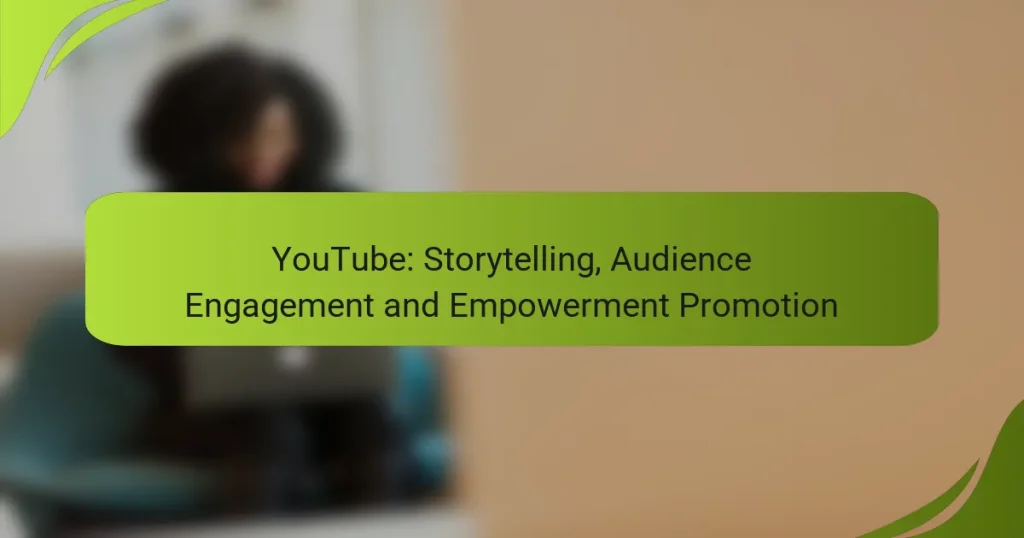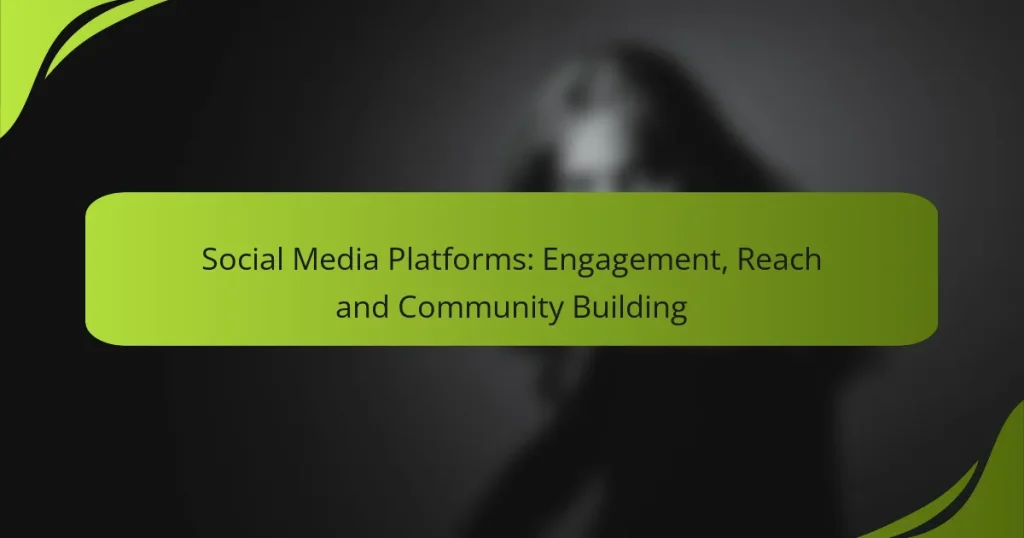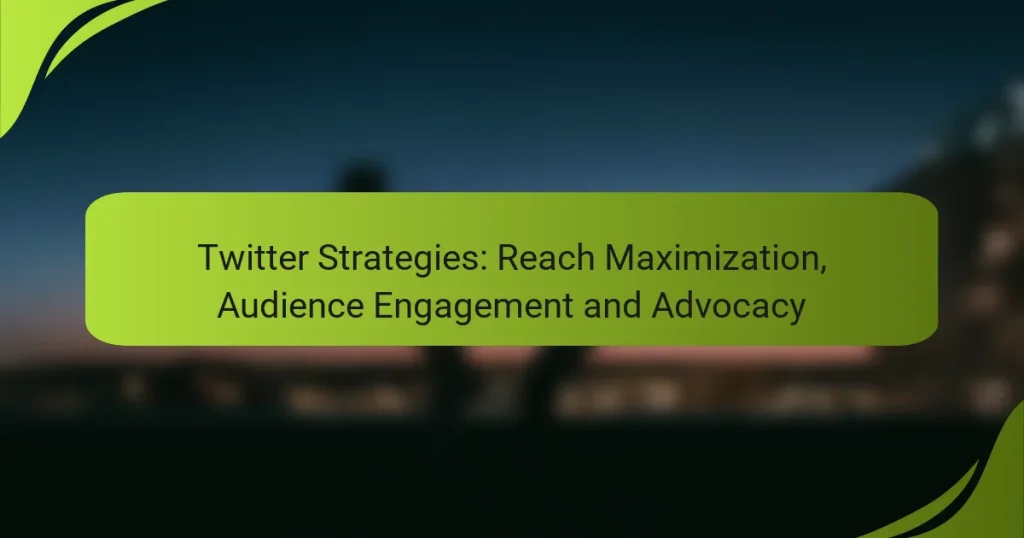Digital platforms are essential for advancing women’s empowerment campaigns by offering innovative tools for outreach and community engagement. These platforms enhance visibility and foster support, enabling organizations to connect with wider audiences and share impactful narratives. By employing targeted strategies and collaborations, campaigns can effectively mobilize resources and drive meaningful change.
Social Media Platforms: Engagement, Reach and Community Building
Crowdfunding Platforms: Effectiveness, Funding Strategies and Project Visibility
Twitter Strategies: Reach Maximization, Audience Engagement and Advocacy
Facebook Groups: Community Support, Networking and Resource Sharing
Instagram: Features, Audience Engagement and Advocacy
Engagement Metrics: Analysis, Comparison and Insights
Which digital platforms empower women’s campaigns in the US?
Several digital platforms play a crucial role in empowering women’s campaigns in the US by providing tools for outreach, engagement, and community building. Each platform offers unique features that can enhance the effectiveness of campaigns aimed at women’s empowerment.
Facebook for community building
Facebook is a powerful tool for community building, allowing organizations to create groups and pages dedicated to women’s issues. These spaces foster discussions, share resources, and mobilize supporters around specific causes.
To maximize engagement, campaigns should regularly post updates, host live events, and encourage members to share their stories. Utilizing Facebook’s event features can help in organizing rallies or workshops that promote women’s empowerment.
Instagram for visual storytelling
Instagram excels in visual storytelling, making it ideal for campaigns that aim to inspire and engage through imagery. High-quality photos, infographics, and short videos can effectively convey messages related to women’s empowerment.
Using relevant hashtags and collaborating with influencers can expand reach and visibility. Regularly posting engaging content, such as success stories or behind-the-scenes looks at initiatives, can help maintain audience interest.
Twitter for real-time engagement
Twitter is effective for real-time engagement, allowing campaigns to participate in ongoing conversations and trending topics related to women’s rights. Quick updates, calls to action, and sharing relevant news can keep followers informed and involved.
Using Twitter polls and threads can encourage interaction and feedback from the community. It’s essential to monitor mentions and respond promptly to foster a sense of connection and urgency.
LinkedIn for professional networking
LinkedIn serves as a platform for professional networking, making it suitable for campaigns focused on women’s leadership and career advancement. Organizations can share articles, host webinars, and connect with industry leaders to promote women’s empowerment in the workplace.
Engaging with professional groups and participating in discussions can help raise awareness and build partnerships. Highlighting success stories of women in leadership roles can inspire others and attract attention to the campaign.
YouTube for educational content
YouTube is an excellent platform for disseminating educational content related to women’s empowerment. Creating informative videos, tutorials, and interviews can help educate viewers on important issues and provide practical advice.
To enhance reach, campaigns should optimize video titles and descriptions with relevant keywords and promote content across other social media platforms. Regularly uploading content and engaging with viewers through comments can build a loyal audience.
How can social media enhance women’s empowerment campaigns?
Social media can significantly enhance women’s empowerment campaigns by increasing visibility, fostering community support, and encouraging user-generated content. These platforms allow organizations and individuals to connect with a broader audience, share impactful stories, and mobilize resources effectively.
Increased visibility and reach
Social media platforms like Facebook, Instagram, and Twitter provide a vast audience for women’s empowerment campaigns. By utilizing targeted hashtags and engaging visuals, campaigns can reach thousands, if not millions, of users quickly. This increased visibility can attract attention from potential supporters, partners, and media outlets.
To maximize reach, campaigns should post content during peak engagement times and consider using paid promotions to further amplify their message. Regularly updating content and engaging with followers can also help maintain visibility over time.
Fostering community support
Social media creates a space for individuals to connect and support one another, fostering a sense of community around women’s empowerment. Groups and pages dedicated to specific issues allow users to share experiences, resources, and encouragement, which can be particularly powerful for marginalized women.
Encouraging discussions and sharing personal stories can strengthen community bonds. Campaigns should actively engage with their audience by responding to comments and creating polls or discussions to solicit feedback and ideas.
Encouraging user-generated content
User-generated content (UGC) can significantly enhance the authenticity and relatability of women’s empowerment campaigns. By encouraging followers to share their own stories, photos, or videos, campaigns can create a more inclusive narrative that resonates with a wider audience.
To promote UGC, campaigns can run contests or challenges that incentivize participation. Clear guidelines on how to share content and the use of specific hashtags can help organize submissions and increase visibility for the campaign as a whole.
What are effective strategies for using digital platforms?
Effective strategies for using digital platforms in women’s empowerment campaigns include targeted advertising, collaborations with influencers, and content diversification. These approaches help reach specific audiences, leverage trusted voices, and engage users through varied formats.
Targeted advertising campaigns
Targeted advertising campaigns focus on reaching specific demographics that align with the campaign’s goals. Utilizing data analytics, organizations can identify key characteristics of their audience, such as age, location, and interests, to tailor their messages effectively.
For example, a campaign aimed at young women in urban areas might use social media platforms like Instagram and TikTok, where this demographic is highly active. Setting a budget that allows for flexible spending can help optimize ad performance based on engagement metrics.
Collaborations with influencers
Collaborating with influencers can amplify the reach and credibility of women’s empowerment campaigns. Influencers often have established trust with their followers, making their endorsements more impactful.
When selecting influencers, consider their alignment with the campaign’s values and audience. Micro-influencers, who typically have smaller but highly engaged followings, can be particularly effective and cost-efficient, often charging lower fees than larger influencers.
Content diversification
Content diversification involves using various formats and channels to engage audiences effectively. This can include videos, podcasts, blogs, and social media posts, catering to different preferences and consumption habits.
For instance, a campaign might produce short videos for social media, in-depth articles for blogs, and interactive webinars to foster community engagement. Regularly assessing which types of content resonate most with the audience can help refine strategies over time.
What metrics measure the success of women’s empowerment campaigns?
Success in women’s empowerment campaigns can be measured through various metrics that reflect engagement, conversion, and audience growth. These metrics provide insights into how effectively a campaign resonates with its target audience and achieves its goals.
Engagement rates
Engagement rates indicate how actively participants interact with campaign content. This can include likes, shares, comments, and overall participation in discussions or events. High engagement rates often suggest that the campaign is resonating well with its audience.
To calculate engagement rates, divide the total interactions by the total reach or impressions, then multiply by 100 to get a percentage. Aiming for engagement rates in the range of 5-10% is typically considered effective for digital campaigns.
Conversion rates
Conversion rates measure the percentage of individuals who take a desired action after engaging with the campaign, such as signing up for newsletters, donating, or participating in programs. This metric is crucial for assessing the campaign’s effectiveness in driving specific outcomes.
To improve conversion rates, ensure that calls to action are clear and compelling. A good conversion rate for digital campaigns often falls between 2-5%, but this can vary based on the campaign’s goals and audience demographics.
Audience growth
Audience growth tracks the increase in followers, subscribers, or participants over time. This metric reflects the campaign’s ability to attract new supporters and expand its reach. A steady growth rate indicates that the campaign is gaining traction and interest.
To foster audience growth, leverage social media platforms and community engagement strategies. Aiming for a growth rate of 10-20% month-over-month can be a solid target, depending on the campaign’s resources and outreach efforts.
What are the challenges of using digital platforms for women’s campaigns?
Digital platforms present several challenges for women’s empowerment campaigns, including algorithm changes, audience engagement, and content moderation. These factors can significantly impact the visibility and effectiveness of campaigns aimed at promoting women’s rights and equality.
Algorithm changes affecting visibility
Algorithm changes on social media and other digital platforms can drastically alter how content is displayed to users, impacting visibility for women’s campaigns. These changes can lead to reduced reach, making it harder for campaigns to connect with their target audience.
To navigate these shifts, campaigners should stay informed about platform updates and adjust their strategies accordingly. Regularly analyzing engagement metrics can help identify what types of content resonate best with audiences, allowing for more effective targeting.
Additionally, using a mix of content formats—such as videos, infographics, and live events—can enhance engagement and improve visibility. Campaigns that adapt quickly to algorithm changes are more likely to maintain a strong presence in the digital space.






